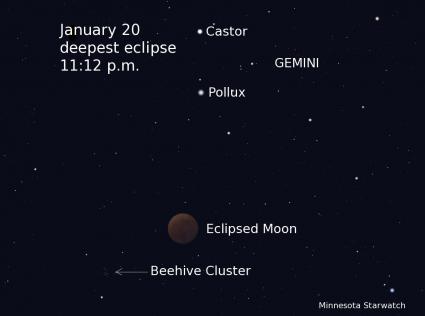Northern Sky: January 19 - February 1, 2019
NORTHERN SKY
Deane Morrison
As January heads into the home stretch, the morning show, starring Venus and Jupiter, is still going strong. Brilliant Venus has begun a descent into the sunrise, as it does whenever it’s getting ready for another trip behind the sun. Meanwhile, Earth is gaining on Jupiter in the orbital race, and this makes Jupiter climb through the morning sky. On Tuesday, January 22nd, Jupiter slides past Venus on its way up. At the end of the month, Jupiter and Venus will be about nine degrees apart.
Also on January 31st, you’ll see a waning crescent moon close to Venus. And, if skies are dark, the red star Antares, in Scorpius, off to the right of Jupiter, at about the same distance as Venus. On February 1st, a thinner crescent moon appears below Venus. If you imagine a line from Venus to the moon and extend it down toward the horizon, you may spot Saturn. Earth is catching up to Saturn, too, so the ringed planet is also on its way up in the morning.
But the real show happens in the evening sky on the night of Sunday, January 20, when we get a total eclipse of a supermoon. This full moon deserves that name because it’ll be less than 24 hours from perigee, its closest approach to Earth in a lunar cycle. When the moon rises over Grand Marais—at 4:17 p.m.—you may notice that it’s bigger and brighter than your average full moon. Now, here is a play by play of the eclipse.
At 9:34 p.m. the moon’s leading edge makes contact with the Earth’s umbra, or dark inner shadow, and the shadow starts to spread.
At 10:41 p.m. totality begins. The moon is now completely engulfed in the umbra. An observer on the moon would see a total solar eclipse, due to Earth blotting out the sun. The observer may also see a ring of fire around the Earth. The red ring comes from Earth’s atmosphere bending red light from sunsets and sunrises into the umbra, and some of it hits the moon. From our point of view, this light often turns the moon’s face reddish—what we call a blood moon—during a total lunar eclipse.
At 11:12 p.m. the moon passes closest to the center of the umbra, and it’ll be in deepest shadow.
At 11:43 p.m. totality ends. At this point, the leading edge of the moon breaks out of the umbra.
At 12:51 a.m. on January 21, the moon frees itself from the last vestiges of umbra and the show is over.
During the height of a lunar eclipse, if you can see the darkened moon or at least remember where it was with respect to the stars when it disappeared, you can use it to find astronomical objects that otherwise would have been washed out by moonlight. This time, you may find the dim but lovely Beehive star cluster. Look to the lower left of the moon, about 12 moon widths away.
The Beehive is a feature of Cancer, the crab. It’s between Gemini, one of the winter constellations, and Leo, the quintessential spring constellation. To the naked eye it’s just a fuzzy spot, but with binoculars, you can make out the stars. In 1609 Galileo was the first to observe the Beehive telescopically. He counted 36 stars, but there are actually more like a thousand. The Beehive’s Latin name is Praesepe, or manger. The cluster is framed by two stars called Aselli, which are donkeys feeding at the manger. The Beehive’s stars were all born in the same stellar nursery and have stayed together for the approximately 600 million years of their lifetime.
Tweet




